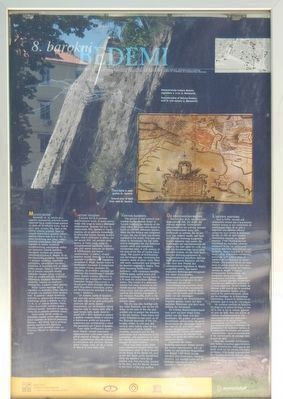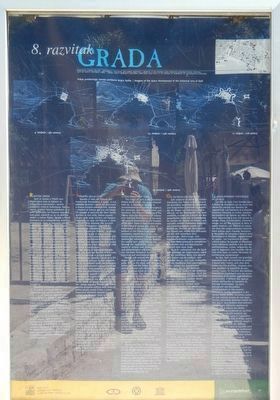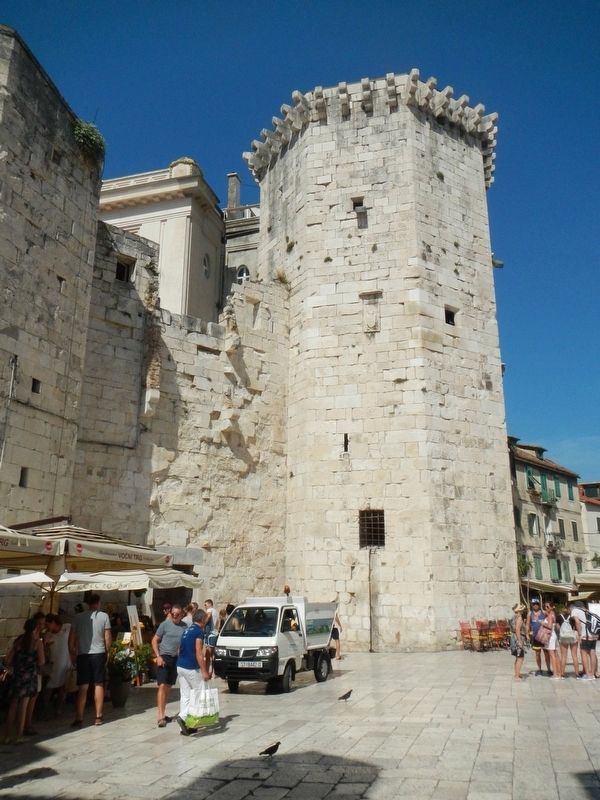Split in Opcina Split, Split-Dalmatia, Croatia — Central and Southeastern Europe
barokni Bedemi
razvitak Grada
Inscription.
The text of this marker appear at the bottom in five languages; Croatian, Italian, English, German and French. Only the English text (center) has been transcribed. To view the text in another language, click on the marker image to enlarge and display them.
(Side A:)
The period of the 16th century was marked by the serious threat of Turkish invasion, so majority of the cities along the coast were forced to build an efficient defensive system, When the Klis fortress was conquered in 1537, the city of Split was directly exposed to the threat. First step was taken to reconstruct the city walls and to strengthen the city defensive system which was completely transformed later, in 17th century, at the time of the War of Candia (1645-1669). The system of fortifications was star-shaped one, comprising five bastions made of stone walls, filled with earth, constructed and designed by Venetian engineer, A. Maglia. They were imposing fortifications - bullwarks - with numerous trenches, artillery posts, sentry posts and defensive passages, having been in a fit state for immediate defense action. This model of a defensive system had been invented by the French marshal Sebastien Vauban (1633-1707), and was particularly used by the military strategists of the Venetian Republic, both in the eastern Mediterranean and along the Adriatic coast.
The city was also fortified with two bastions, one on the hill Gripe, to the east of the city and another one to protect the city harbour. These heavy and costly investments had used up all the financial resources of the city budget, which, in 17th and 18th century, were mainly used for the construction of some modest churches, mansions and for the construction and maintenance of the Lazarettos - the quarantine for both the merchants and the goods passing through the Split harbour.
There have been some other rural settlements beyond these new fortifications, some of them located on the slope of the Marjan hill, such as the Veli Varoš, partly demolished while the bastions were being erected, and then the Lučac, located to the east, and the Manuš, located to the north of the city nucleus.
(Side B:)
The origin of Split is the Diocletian Palace itself, which has been adapted both as a residential quarter to accommodate local citizens throughout the centuries, and for some other civil functions. The first civil residents of the Palace were the inhabitants of Salona who fled from Salona in the early 7th century, threatened by the invasion of the Slavs. Some of them found shelter in the imperial palace and some of them sailed to
nearby islands. The edifices of the Palace have been constantly transformed to the new functions the Emperor's Mausoleum has become the Cathedral, and the Peristyle, the central part of the Palace, has become the main public square, the center of various civil, religious, public and administrative activities. The new city has been formed in a unique historical and architectural setting.
During 10th century, the city of Split began to spill out beyond the Palace walls, First to the west, and then even farther out from the Palace. Accordingly, during the 12th and 13th century, the new urban area was twice as large as its original nucleus. The churches have been erected by the country roads leading to the landowners properties or to the villages around the city, representing specific spiritual as well as spatial landmarks in the environment. There are not only archaeological remains left today, but also written records, dating from the later centuries. Some routes, even today, follow the original Roman territorial division from 1th (sic) century B.C., and have been maintained as important spatial elements throughout the centuries.
In 14th century the west suburb was bordered by the new walls, having protected the city from the Turkish invasion in 16th and 17th century. The new defensive system was built around the city, pursuant to the military strategy of that period. The mansion houses of the wealthy citizens were erected in Romanesque and Gothic style in the new urban zone. At that time some of the churches and convents were incorporated in the new zone (St. Mary, St. Spirit).
During the time of the Venetian-Turkish wars, in 16th and 17th century, the city of Split was encircled by modern star-shaped bastions, for the purpose of defending the city. During the period of French administration in Dalmatia (early 19th century), certain parts of the bastions were pulled down, so the city could spread out of the boundaries towards the new free territory, in the fields surrounding the city.
Erected by Grad Split, Gradosro Poglavarstvo. (Marker Number 8.)
Topics. This historical marker is listed in these topic lists: Architecture • Forts and Castles • Settlements & Settlers.
Location. 43° 30.575′ N, 16° 26.427′ E. Marker is in Split, Splitsko-dalmatinska (Split-Dalmatia), in Opcina Split. Marker is on Ulica kralja Tomislava close to Ulica Natka Nodlia, on the right when traveling east. Touch for map. Marker is in this post office area: Split, Splitsko-dalmatinska 21000, Croatia. Touch for directions.
Other nearby markers. At least 8 other markers are within walking distance of this marker. Zlatna Vrata (a few steps from this marker); vrata od Pisture (within shouting distance of this marker); The Golden Gate Palace (within shouting distance of this marker); The Church of St Martin (within shouting distance of this marker); The Dragišić (De Caris) Palace (about 90 meters away, measured in a direct line); The Large Papalić Palace (about 90 meters away); The Cambi Palace (about 120 meters away); The Marulić Palace (about 120 meters away). Touch for a list and map of all markers in Split.
More about this marker. This marker is located near the Statue of Grgur Ninski, (Gregory of Nin).
Additional keywords. barokni Bedemi
Credits. This page was last revised on February 10, 2022. It was originally submitted on January 8, 2019, by Barry Swackhamer of Brentwood, California. This page has been viewed 152 times since then and 19 times this year. Photos: 1, 2, 3. submitted on January 8, 2019, by Barry Swackhamer of Brentwood, California.


